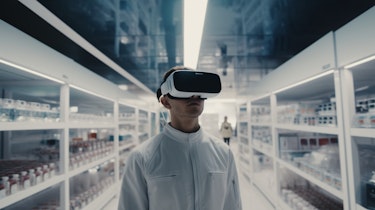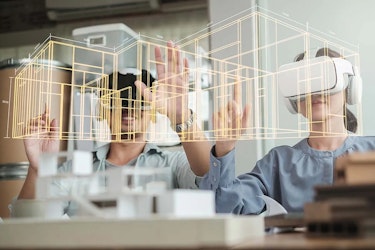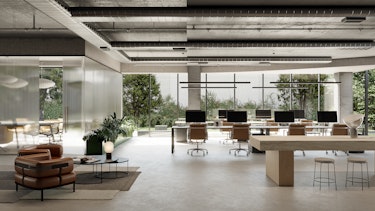In the ever-evolving realm of architecture, the integration of cutting-edge technology has revolutionized the way architects and designers conceptualize, plan, and communicate their ideas. Virtual Reality (VR) has emerged as a groundbreaking tool that is transforming the field of architecture. It allows architects to step inside their designs, engage clients in immersive experiences, collaborate more effectively, and enhance overall project efficiency. In this essay, we will delve into how the use of virtual reality in architecture is becoming increasingly significant, exploring the impact it has on design visualization, client engagement, collaboration, and efficiency.

Credit: Medium
1. Design Visualization: Bridging the Imagination Gap
Virtual Reality offers architects an unprecedented opportunity to bridge the gap between imagination and reality. Traditionally, architects relied on two-dimensional drawings and static 3D models to convey their design concepts. While these methods served their purpose, they often fell short in fully communicating the spatial qualities and the experiential aspects of a design. VR, however, empowers architects to create immersive, interactive 3D environments that provide a true sense of scale, proportion, and spatial relationships.
Through VR, architects can navigate through their designs as if they were physically present within them. This level of immersion enables them to identify design flaws, spatial inefficiencies, and aesthetic considerations more effectively. Furthermore, it aids in making design decisions, as architects can experience the design from various angles, lighting conditions, and even simulate user interactions. The result is a richer, more informed design process, ultimately leading to better architecture.

Credit: Adorama
2. Client Engagement: Enabling Informed Decisions
One of the key advantages of incorporating virtual reality in architecture is the ability to actively engage clients in the design process. For clients, understanding architectural plans and visualizing the end product can be challenging, as they often lack the technical expertise to interpret traditional architectural drawings. VR solves this problem by offering a highly intuitive and immersive way for clients to explore and understand architectural designs.
With VR, clients can put on a headset and walk through their future space, experiencing the design firsthand. This not only enhances their understanding of the project but also empowers them to make informed decisions. They can provide feedback on the design in real-time, enabling architects to make adjustments and refinements on the spot. As a result, the design process becomes a collaborative effort, where architects and clients work together to ensure that the final product aligns with the client's vision and needs.

3. Collaboration: Breaking Down Communication Barriers
In the architecture and construction industry, collaboration is a fundamental aspect of successful project delivery. VR has emerged as a transformative tool for enhancing collaboration among architects, designers, engineers, and other stakeholders. It overcomes the limitations of traditional communication methods by enabling real-time, interactive, and immersive collaboration.
Architectural projects often involve a myriad of professionals with diverse expertise. With VR, these professionals can virtually come together in a shared digital environment, regardless of their physical locations. They can simultaneously review and discuss designs, identify potential issues, and provide input, all in a collaborative and dynamic manner. This not only expedites the decision-making process but also ensures that everyone involved in the project has a clear understanding of the design intent.

4. Efficiency: Streamlining the Design Process
Efficiency is a critical factor in architecture, where time and resources are often limited. Virtual reality plays a vital role in streamlining the design process, reducing errors, and saving both time and money. Through VR, architects can conduct design iterations rapidly and assess the impact of design changes immediately. This quick feedback loop allows for a more agile and responsive design approach, which is especially valuable in complex and time-sensitive projects.
Moreover, virtual reality aids in minimizing construction errors. By identifying design flaws or inconsistencies before construction begins, costly modifications and delays can be avoided. The immersive nature of VR also assists in conveying design details and intent to contractors, reducing the likelihood of misinterpretations.
Additionally, VR can be instrumental in sustainability considerations. Architects can use VR to simulate various environmental conditions, such as natural lighting and thermal comfort, to optimize energy efficiency and reduce the building's ecological footprint.

5. Cost-Effective Training and Simulation
Beyond design and construction phases, virtual reality is also making inroads into architectural education and professional training. Architecture students can use VR to explore historic buildings, iconic structures, and renowned architectural designs from around the world, offering them valuable experiential learning opportunities. In addition, VR can be used for simulating architectural emergencies, such as fire evacuations or earthquake scenarios, providing architects and building managers with tools to develop safer and more resilient structures.

6. Future of Virtual Reality in Architecture
The significance of virtual reality in architecture continues to grow, and the future holds even more promise. As technology evolves, VR hardware becomes more accessible and affordable, making it a viable tool for architects of all scales and budgets. With the advent of augmented reality (AR), which overlays digital information onto the real world, architects will have new opportunities to blend the virtual and physical environments, offering enhanced design and construction experiences.
Moreover, the potential for VR in architectural marketing and presentations is substantial. Real estate developers, for instance, can use VR to showcase properties to potential buyers, providing immersive experiences that convey the atmosphere and functionality of spaces that are yet to be built.
As virtual reality continues to become an integral part of architectural practice, architects must adapt and develop new skills to leverage this technology to its fullest potential. Additionally, ethical considerations around privacy and data security will become increasingly important as VR is used in sensitive architectural applications.

The use of virtual reality in architecture is rapidly becoming increasingly significant, and it is transforming the way architects design, communicate, and collaborate. By enhancing design visualization, engaging clients in informed decisions, fostering collaboration among professionals, streamlining the design process, and offering cost-effective training and simulation opportunities, VR is revolutionizing the field of architecture.
In the years to come, virtual reality will play an even more integral role in architectural practice, with the potential to change how buildings are designed, constructed, and experienced. Architects who embrace this technology will be better positioned to create innovative, efficient, and sustainable structures that meet the ever-evolving needs of society. As the architectural world continues to embrace virtual reality, we are on the brink of a new era in design and construction, where imagination knows no bounds, and architecture becomes an even more immersive and inclusive experience.
.jpg?ixlib=gatsbyFP&auto=compress%2Cformat&fit=max&q=75&w=375)